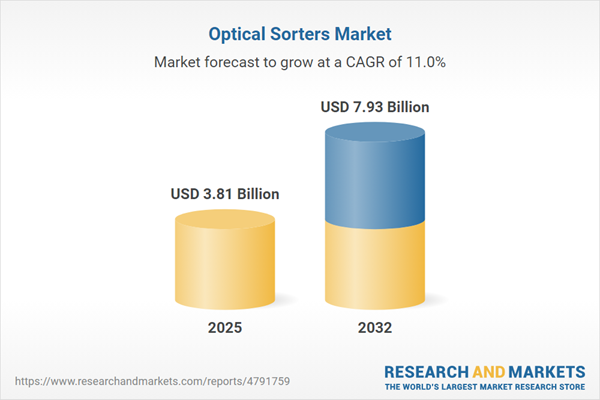Speak directly to the analyst to clarify any post sales queries you may have.
The Optical Sorters Market is rapidly evolving, fueled by advances in AI-driven detection and robust demand in food, mining, and recycling industries. Senior executives evaluating capital allocation and operational upgrades will find critical insights to navigate dynamic market challenges and emerging opportunities.
Market Snapshot: Optical Sorters Market Size and Growth
The Optical Sorters Market grew from USD 3.44 billion in 2024 to USD 3.81 billion in 2025. The market is set to expand at a CAGR of 10.99%, with revenue expected to reach USD 7.93 billion by 2032.
Scope & Segmentation of the Optical Sorters Landscape
This comprehensive study provides market analysis through detailed segmentation and monitors key regional and technological trends:
- Type: Cameras, Hyperspectral Cameras & Combined Sorters, Lasers, Near-Infrared (NIR) Sorters.
- Platform: Belt, Freefall, Hybrid, Lane.
- Application: Food, Mining, Recycling.
- Regional Focus: Americas, Europe, Middle East & Africa, Asia-Pacific.
- Key Markets: United States, Canada, Mexico, Brazil, Argentina, Chile, Colombia, Peru, United Kingdom, Germany, France, Russia, Italy, Spain, Netherlands, Sweden, Poland, Switzerland, United Arab Emirates, Saudi Arabia, Qatar, Turkey, Israel, South Africa, Nigeria, Egypt, Kenya, China, India, Japan, Australia, South Korea, Indonesia, Thailand, Malaysia, Singapore, Taiwan.
- Leading Companies: TOMRA Sorting Solutions AS, Bühler AG, Key Technology Inc., Satake Corporation, Aweta B.V., GREEFA B.V., CP Machineries Co., Ltd., S+S Separation and Sorting Technology GmbH.
Key Takeaways for Senior Decision-Makers
- Advancements in sensor technologies, such as hyperspectral and near-infrared detection, are enabling precise material identification across diverse processing lines and improving product consistency.
- The integration of artificial intelligence, machine learning, and real-time imaging is increasing throughput rates and minimizing human error in sorting processes.
- Companies are increasingly adopting modular sorting systems, providing flexibility for scaling capacity and integrating with digital supply chain infrastructures.
- Emerging service models like pay-per-use platforms and performance-based agreements are lowering entry barriers and speeding up adoption, particularly for medium-sized enterprises.
- Tailored solutions address sector-specific needs, from contaminant removal in food to high-purity resource sorting in recycling and mineral recovery.
- Collaborative partnerships among manufacturers, automation vendors, and analytics providers are critical to delivering end-to-end, actionable insights and efficiency gains.
Tariff Impact on Supply Chains and Sourcing Strategies
The 2025 adjustment of United States tariffs is influencing sourcing and procurement cycles for optical sorting equipment. Businesses are diversifying supplier networks and strengthening regional manufacturing relationships to counteract cost fluctuations and mitigate risks from cross-border dependencies. Alternative financing, including leasing and subscription models, is helping spread capital costs, enhancing supply chain resilience, and supporting agility in strategic sourcing decisions.
Methodology & Data Sources
This report applies a dual-phase research framework, combining in-depth interviews with seasoned industry experts and a thorough review of secondary data sources. Insights from technical journals, regulatory documents, and industry consortiums form the foundation for analysis and validation. Cross-sectional comparison, sensitivity analyses, and technology adoption modeling underpin the study’s credibility and actionable recommendations.
Why This Report Matters for Stakeholders
- Enables data-driven investment and procurement decisions tailored to evolving operational needs and regulatory demands in optical sorting technology.
- Delivers comprehensive segmentation and regional intelligence for effective portfolio management and strategic market entry.
- Guides on adapting to tariff changes, digital transformation initiatives, and best practices in system integration and workforce training.
Conclusion
The Optical Sorters Market presents substantial growth and innovation prospects for industry leaders. Well-informed action on technology adoption, flexible sourcing, and workforce upskilling will position organizations for sustainable operational excellence and competitive advantage.
Additional Product Information:
- Purchase of this report includes 1 year online access with quarterly updates.
- This report can be updated on request. Please contact our Customer Experience team using the Ask a Question widget on our website.
Table of Contents
3. Executive Summary
4. Market Overview
7. Cumulative Impact of Artificial Intelligence 2025
Companies Mentioned
The companies profiled in this Optical Sorters market report include:- TOMRA Sorting Solutions AS
- Bühler AG
- Key Technology, Inc.
- Satake Corporation
- Aweta B.V.
- GREEFA B.V.
- CP Machineries Co., Ltd.
- S+S Separation and Sorting Technology GmbH
Table Information
| Report Attribute | Details |
|---|---|
| No. of Pages | 199 |
| Published | October 2025 |
| Forecast Period | 2025 - 2032 |
| Estimated Market Value ( USD | $ 3.81 Billion |
| Forecasted Market Value ( USD | $ 7.93 Billion |
| Compound Annual Growth Rate | 10.9% |
| Regions Covered | Global |
| No. of Companies Mentioned | 9 |









